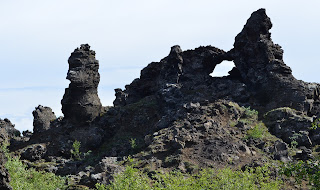 |
| A typical breakfast for us while we are on the road. |
We packed up our campsite and then drove back southeast to the Krafla geothermal area, which sits astride the junction of the American and Eurasian crustal plates. We visited a lava field that formed during a series of eruptions from 1975 to 1984. The lava formations were beautiful and there were many geothermal features, such as mudpots and fumaroles.
 |
| The ground is still so hot that steam wafts from many vents in its surface. |
 |
| Shan, Spencer, Jean, Alex, Bill, and Joslyn on the rim of the Víti volcano, which now has lake in its crater. |
We drove to the neighboring Lake Mývatn. Mývatn means “midge lake” and is so-named because the lake is usually overrun with gnats. Fortunately, we did not have any problems with midges during our visit. Mývatn’s volcanic past has led to the formation of numerous sites worth visiting.
 |
| The girls hike the rim of Hverfell. |
We next stopped at Hverfell, which is a “pseudocrater.” It was formed 2500 to 2900 years ago when rising magma encountered groundwater, which boiled instantly and blew upward and outward. There are other, smaller pseudocraters around Mývatn as well. Apparently, these features are more common on Mars than on Earth. Shan and the kids hiked to the top and took some pictures.
 |
| The Hverfell crater. The girls thought that the central mound looked like a woman's face. The dark soil around it is her hair, and the raised surface to the face's right is her neck. |
 |
| A panorama of Mývatn from Hverfell. Dimmuborgir is to the far left. The islands to the left of the central mountain are more pseudocraters. The Krafla geothermal park is on the right. |
The neighboring Dimmuborgir features were our next stop. These strange volcanic rock formations formed when steam blew through molten lava, solidifying some of the magma around the steam. The rest of the lava drained away, leaving these structures high and dry, as it were. These structures are more common under the ocean along the Mid-Atlantic ridge. We took a short walk through the Dimmuborgir and had some ice cream and coffee at the accompanying restaurant.
The time for relaxation was over as we set off on our marathon drive to the West Fjords. While visiting Gaui and Magga earlier in July, we had made arrangements for Joslyn to spend a few final days with Ágústa before we leave. We stopped briefly at Goðafoss to view the waterfall and ate supper in Blönduós.
 |
| Prestbakki church on the western shores of Hrútafjörður. |
At Miðfjörður we turned off to the north and drove to Hvammstangi. We helped Bill and Jean settle their van into a spot with electricity and then the Hayses loaded into our car and continued on west. Once we got to the base of the West Fjords we turned off and worked our way up the eastern shore of Hrútafjörður. The sky had slowly cleared over the course of the day and the Sun was now at the right angle to cause some real troubles as we made this drive. Not far from our destination, a mink ran across the road in front of us. They were imported into Iceland for farming some years ago, but some has escaped and they now run wild, although farmers are trying to eradicate them.
We finally arrived at Óspakseyri around 11pm. Gaui was outside mowing the lawn at the neighboring church, Magga was inside chatting with a friend from Akranes, and Ágústa was inside playing a card game with her cousin, Íris. Gaui came in and we adults sat around talking, eating cookies, and drinking coffee for the next hour, while the kids played a card game. Around midnight, we figured we should be getting back to the campsite, so we finally pulled ourselves away. As we were leaving, Magga’s brother showed up and the girls all went outside to jump on the trampoline. When it is light around the clock, selecting the time to do daytime activities is a matter of personal choice and is not dictated by the Sun. However, the whole household, including all of the guests, did go to bed not long after we left. Since the Sun was below the horizon and behind us, it was not a problem for our return trip. Sheep must gravitate to the road at night, though, because we repeatedly had to slow down to let them get off as we made the hour-long drive back to the campsite. Bill had been kind enough to put up our tent, so we only needed to put our sleeping pads and bags into it, before we could go to bed.









No comments:
Post a Comment